Judy Bloom Scream and Scream Again
Scream and Scream Once more
Last updated| Scream and Scream Again | |
|---|---|
 Theatrical release poster | |
| Directed by | Gordon Hessler |
| Written by | Christopher Wicking |
| Based on | The Disorientated Man by Peter Saxon |
| Produced past | Max Rosenberg Milton Subotsky Louis G. Heyward |
| Starring |
|
| Cinematography | John Coquillon |
| Edited past | Peter Elliott |
| Music past | David Whitaker |
| Production | American International Pictures |
| Distributed past | Warner-Pathé (Britain) American International Pictures (Us) |
| Release dates | January 1970 (UK) Feb 2, 1970 (US) [1] |
| Running time | 95 minutes |
| State | United Kingdom |
| Language | English |
| Budget | $350,000 [1] |
| Box office | $1,217,000 (Usa/ Canada rentals) [2] |
Scream and Scream Once more is a 1970 British scientific discipline fiction conspiracy thriller moving-picture show starring Vincent Price, Christopher Lee, Alfred Marks, Michael Gothard, and Peter Cushing. Information technology is based on the novel The Disorientated Man (1967) past 'Peter Saxon', a house pseudonym used by various authors in the 1960s and 1970s.
- Plot
- Bandage
- Production
- Reception
- References
- External links
It marks the second teaming, later on The Oblong Box , of actors Price and Lee with director Gordon Hessler. Price and Lee just share a brief scene in the film's climax. Cushing, in his brief scene, shares no screen time with either Cost or Lee.
Although the film's title, and clan with stars Cost, Lee and Cushing, might suggest a violent horror film, the violence in the film is mostly understated and/or off-screen, while the plot owes more to films like Invasion of the Body Snatchers or 1970's era 'conspiracy thrillers' like The Parallax View .
Overlooked during its initial release, the moving-picture show has since become a modest cult classic, with the Overlook Film Guide acknowledging it as: "one of the best science-fiction films made in Britain."
Plot
The moving-picture show's structure is fragmented, as information technology alternates betwixt 3 plot threads.
A man jogging through suburban London grabs his heart, and collapses. He wakes upwardly in a hospital bed. The nurse tending him gives him water and leaves. He pulls downward the bed covers to discover that his lower right leg has been amputated. He screams. Afterward scenes repeat the same action as his other limbs are amputated.
Elsewhere, intelligence operative Konratz (Marshall Jones) returns to his home land, an unidentified Eastern European totalitarian state. Afterwards beingness debriefed by Captain Schweitz (Peter Sallis), Konratz steps effectually the table and places a manus on Schweitz's shoulder, paralysing and then killing him. Konratz is later reprimanded by his superior Major Benedek (Peter Cushing) for his torturing an escapee, Erika (Yutte Stensgaard ). Konratz kills Major Benedek in the same fashion.
In London, MPS Detective Superintendent Bellaver (Alfred Marks) investigates the rape and murder of a young woman, Eileen Stevens. Supt. Bellaver goes with young forensic pathologist Dr. David Sorel (Christopher Matthews) to the dispensary of her employer Dr. Browning (Vincent Price), only he provides no useful information. A young woman, Sylvia (Judy Huxtable), is picked up at the Busted Pot Disco by the sinister Keith (Michael Gothard). She is killed by Keith, and her body is later found drained of claret.
The 2 young women accept evidently been raped and murdered by the same individual. Supt. Bellaver sends out several young policewomen to try to entrap the killer. WPC Helen Bradford (Judy Blossom), wearing a wire and electronic tracer, goes to the same gild where she lets herself get picked up and driven away by Keith. The constabulary follow and arrive just afterwards Keith has attacked her and appears to be drinking blood from her wrist. With apparent superhuman strength, Keith fights off the arresting police and drives off, start a long chase sequence by machine and on pes through suburban London, during which Keith tears off his arm in an endeavour to escape, and which ends at an manor where he throws himself into a vat of acid in an outbuilding. The building turns out to vest to Dr. Browning, who explains that he uses the acid to destroy possible pathogens in his biological experiments.
The narrative strands begin to come together when a senior U.k. Government officer, Fremont (Christopher Lee) meets Konratz at London'due south Trafalgar Square. Soon after, Supt. Bellaver is ordered to cease his investigations, but Dr. Sorel decides to go on on his own. Accompanied by WPC Bradford, he goes to Dr. Browning's laboratory, seemingly unoccupied, but she and their motorcar disappear. Later, she wakes up restrained in the same hospital bed with the same nurse attending her every bit the dismembered jogger.
Returning to Dr. Browning'south house, Dr. Sorel discovers Browning is almost to surgically operate on WPC Bradford, in part of a plot to replace human beings with composites, bogus beings. Konratz appears, and is angry that Dr. Browning's deportment accept interfered with his office of the plot. When Browning expresses misgivings, he and Konratz struggle. Konratz is pushed into a vat of acid in the laboratory room. Fremont appears and struggles with Dr. Browning, who also falls into the acid. Fremont, Dr. Sorel, and WPC Bradford escape, although to an uncertain future.
Cast
- Vincent Price as Dr. Browning
- Christopher Lee equally Fremont
- Peter Cushing every bit Benedek
- Judy Huxtable (billed as "invitee star") as Sylvia, 1st immature woman at disco
- Alfred Marks as Detective Superintendent Bellaver
- Michael Gothard equally Keith
- Anthony Newlands equally Ludwig
- Peter Sallis as Schweitz
- David Lodge equally Detective Inspector Strickland (end-title credit merely)
- Uta Levka as Jane, nurse
- Christopher Matthews every bit Dr. David Sorel
- Judy Flower (billed as Judi Bloom) as WPC Helen Bradford
- Clifford Earl every bit Detective Sergeant Jimmy Joyce
- Kenneth Benda as Professor Kingsmill
- Marshall Jones every bit Konratz
- Amen Corner as themselves
- Yutte Stensgaard as Erika, escaping woman (uncredited)
- Julian Holloway as Detective Constable Griffin (opening-title credit only)
- Nigel Lambert as Ken Sparten (uncredited)
- Kay Adrian every bit Nurse (uncredited)
- Edgar D. Davies as Rogers (uncredited)
- Rosalind Elliot as Valerie, 2nd young adult female at disco (uncredited)
- Leslie Ewin as Tramp (uncredited)
- Lee Hudson as Matron (uncredited)
- Gertan Klauber as Edge Guard (uncredited)
- Olga Linden as Eileen Stevens (uncredited)
- Stephen Preston equally Fryer (uncredited)
- Joe Wadham as Wadham, Law Driver (uncredited)
- Lincoln Webb as Wrestler (uncredited)
Production
The picture is based on Peter Saxon's scientific discipline fiction novel The Disorientated Man. For the about part, the flick follows the novel quite closely.
In the novel, the antagonists turned out to be aliens. According to an interview with Christopher Lee, the characters were indeed going to exist revealed every bit aliens in the movie's climax, but all connections to that fact were cut out of the moving-picture show before information technology was released, leaving the enigmatic villains' backgrounds unexplained. [3]
Rights to the novel were bought past Milton Subotsky of Amicus Productions who got financing from Louis Heyward head of European operations for AIP. [one]
There was a script past Subotsky but it was regarded as unplayable. [4] Gordon Hessler says he got Chris Wickling to heavily rewrite it:
That was actually a pulp book, a throwaway book that you read on a train. In that location was nil in it, simply empty pieces of action. Just it was Chris who gave it a whole new level past using information technology as a political procedure of what might happen in the hereafter. That is what made the picture show, he'due south the 1 that came up with all those ideas, nonetheless he notwithstanding managed to keep the nuances of the sort of pulp fiction novel. [5]
The eponymous theme vocal for the picture was by Amen Corner, who appeared in the film singing it. This was one of their last appearances before Andy Fairweather Depression departed for a solo career later a brief career every bit Fair Atmospheric condition.
This marked the first fourth dimension that horror-movie icons Peter Cushing, Vincent Cost and Christopher Lee appeared in the same feature-film. The three actors however, practise non share screen space. Cushing does non appear with either Lee or Price - only actualization in a cameo. Lee and Price share a cursory scene towards the film'southward climax.
The film was made in the bridge of a month, starting on five May 1969 at Shepperton, having location work done at Trafalagar Square and Chertsey, Surrey. Though the film has a release engagement of 1970, the copyright lists 1969. [6] In the last scene, Christopher Lee'south Bentley has a tax disc with an death appointment of December 1969 thus strongly consistent with a production of 1969.
An episode of The X-Files , "Impale Switch", depicts Agent Fox Mulder in a virtual reality experience during which, like this flick's victim, nurses periodically amputate his limbs while he sleeps.
Reception
Reviews from critics were mixed. Howard Thompson of The New York Times wrote that the film "tools along intriguingly for a while with some genuine possibilities earlier taking a nosedive" when it "ends up in notwithstanding another mad scientist's lair." [7] Variety wrote that the script "has almost as many holes as the assorted victims of the action. All the same, such criticism is completely irrelevant to the motion-picture show's gripping momentum of horror." [8] Roger Ebert gave the film ii stars out of iv, calling it "ridiculous" yet "impossible to dislike because they ask simply that y'all share their sense of the absurd. The fascinating thing virtually this one is that it makes absolutely no sense at all until maybe the last x minutes. None." [9] Gene Siskel of the Chicago Tribune gave the film one star, calling it "a tearing and sick film ... that begs to be included in our almanac worst twenty list." [10] Kevin Thomas of the Los Angeles Times chosen the film "a superb piece of contemporary horror, a science fiction tale possessed of a credibility more than terrifying than whatever of the Gothic witchery of 'Rosemary's Infant' ... Information technology's ane of those movies where you have no idea what's going on until the end, but once at that place, there's no letdown." [11]
On Rotten Tomatoes the motion-picture show has an approval rating of 64% based on fourteen reviews, with an average rating of five.45 out of 10. [12]
Related Research Articles
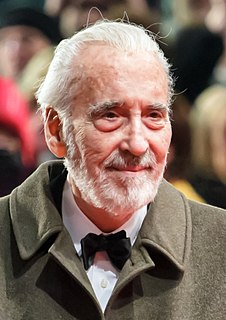
Sir Christopher Frank Carandini Lee was an English actor, author, and singer. With a career spanning nigh seven decades, Lee was well known for portraying villains, gaining recognition for appearing as Count Dracula in seven Hammer Horror films—ultimately playing the part 9 times in full. His other film roles include Francisco Scaramanga in the James Bond film The Man with the Golden Gun (1974), Count Dooku in the Star Wars films Episode 2 – Attack of the Clones (2002) and Episode III – Revenge of the Sith (2005), and Saruman in both the Lord of the Rings film trilogy (2001–2003) and the Hobbit film trilogy (2012–2014).
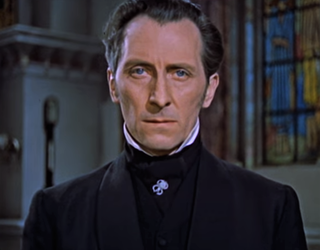
Peter Wilton Cushing was an English actor. His acting career spanned over 6 decades and included appearances in more than 100 films, as well every bit many boob tube, stage, and radio roles. He achieved recognition in his home country for his leading performances in the Hammer Productions horror films from the 1950s to 1970s, while earning international prominence as K Moff Tarkin in the original 1977 Star Wars .
Amicus Productions was a British flick product visitor, based at Shepperton Studios, England, active betwixt 1962 and 1977. Information technology was founded by American producers and screenwriters Milton Subotsky and Max Rosenberg.

Terence Fisher was a British film managing director best known for his work for Hammer Films.

Dr Terror's House of Horrors is a 1965 British horror anthology pic from Amicus Productions, directed by veteran horror manager Freddie Francis, written by Milton Subotsky, and starring Peter Cushing and Christopher Lee.

Geoffrey Keen was an English actor who appeared in supporting roles in many films. He is well known for playing British Defence Minister Sir Frederick Gray in the James Bond films.

Dracula A.D. 1972 is a 1972 British horror motion picture, directed by Alan Gibson and produced by Hammer Picture Productions. It was written by Don Houghton and stars Christopher Lee, Peter Cushing and Stephanie Beacham. Different earlier films in Hammer's Dracula series, Dracula A.D. 1972 had a gimmicky setting in an attempt to update the Dracula story for mod audiences. Dracula is brought back to life in modern London and preys on a group of young partygoers that includes the descendant of his nemesis, Van Helsing.

House of the Long Shadows is a 1983 comedy horror picture show directed by Pete Walker. It is notable considering 4 iconic horror picture show stars are together in 1 feature. The screenplay by Michael Armstrong is based on the 1913 novel Seven Keys to Baldpate past Earl Derr Biggers, which was likewise adapted into a famous play that gave birth in turn to several films. The original music score was composed by Richard Harvey.
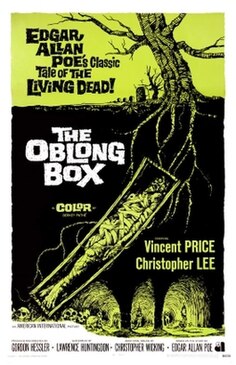
The Ellipsoidal Box is a 1969 British horror film directed past Gordon Hessler, starring Vincent Price, Christopher Lee and Alister Williamson. This was the first movie to star both Price and Lee.

Michael Alan Gothard was an English language role player, who portrayed Kai in the tv set serial Arthur of the Britons and the mysterious villain Emile Leopold Locque in the 1981 James Bond film For Your Eyes Only.
Louis M. "Deke" Heyward was an American producer and film and television screenwriter.
Gordon Hessler was a British film and television director, screenwriter, and producer.
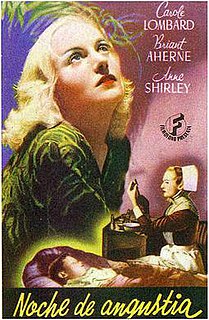
Vigil in the Night is a 1940 RKO Pictures drama flick based on the 1939 serialized novel Acuity in the Night past A. J. Cronin. The film was produced and directed by George Stevens and stars Carole Lombard, Brian Aherne and Anne Shirley.
Alister Williamson was an Australian-born graphic symbol actor, who appeared in many British films and television series of the 1960s and 1970s. A large, craggy-faced man, he would usually be found playing gruff police inspectors or henchmen in hazard series and constabulary dramas of the period. He was also notable equally a supporting player in a number of archetype British horror films.
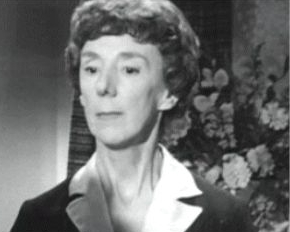
Lucy Griffiths was an English actress whose piece of work spanned from the early 1950s to the early 1980s.

Nothing but the Nighttime is a 1973 British horror motion picture directed by Peter Sasdy and starring Christopher Lee and Peter Cushing.
A horror icon is a person or fictional character that is considered to be pregnant to horror fiction within mediums such as pic, literature, boob tube, or video games.
Peter Saxon is a nom de feather used by various thriller authors from the 1950s to the 1970s.
Frankenstein is the title of several horror-adventure films loosely based on the 1818 novel Frankenstein; or, The Mod Prometheus by Mary Shelley, centered on Baron Victor Frankenstein, who experiments in creating a fauna beyond human being.
Dracula is the title of several horror film series centered on Count Dracula, who is accidentally resurrected, bringing with him a plague of vampirism, and the ensuing efforts of the heroic Van Helsing family to stop him.
References
- 1 2 3 Ed. Allan Bryce, Amicus: The Studio That Dripped Claret, Devious Cat Publishing, 2000. p 56-61. ISBN 9780953326136
- ↑ "Large Rental Films of 1970", Variety, half-dozen Jan 1971 p 11
- ↑ Pohle, Robert; Hart, Douglas; Pohle Baldwin, Rita (2017). The Christopher Lee film encyclopedia. Lanham: Rowman & Littlefield. p.127. ISBN 9780810892705. OCLC 973222703.
If that [beingness an alien] wasn't articulate, it was either in the cutting or the story, considering that indeed was meant to be the solution.
- ↑ All's Well That Ends: an interview with Chris Wicking Monthly Film Message; London Vol. 55, Iss. 658, (Nov one, 1988): 322.
- ↑ George One thousand. Reis, "An Interview with Gordon Hessler", DVD Drive In accessed 27 February 2014
- ↑ "19 Things You Must Know Nearly Scream and Scream Again". The Sound of Vincent Price. February 7, 2017. Retrieved October 10, 2018.
- ↑ Thompsom, Howard (July ix, 1970). "Neighborhoods Become Horror Film Dual Beak". The New York Times : 44.
- ↑ "Scream and Scream Once again". Variety : sixteen. February xi, 1970.
- ↑ Ebert, Roger (February 18, 1970). "Scream And Scream Once more". RogerEbert.com . Retrieved October 10, 2018.
- ↑ Siskel, Gene (Feb xviii, 1970). "Scream Again". Chicago Tribune . Section 2, p. 5.
- ↑ Thomas, Kevin (February 21, 1970). "'Scream Again' Scary Science Fiction Tale". Los Angeles Times . Part Two, p. nine.
- ↑ "Scream And Scream Again (Screamer) (1970)". Rotten Tomatoes . Fandango Media . Retrieved August 8, 2020.
External links
- Scream and Scream Again at IMDb
This page is based on this Wikipedia article
Text is available under the CC BY-SA iv.0 license; boosted terms may apply.
Images, videos and audio are available nether their respective licenses.
Source: https://WikiMili.com/en/Scream_and_Scream_Again
0 Response to "Judy Bloom Scream and Scream Again"
Post a Comment